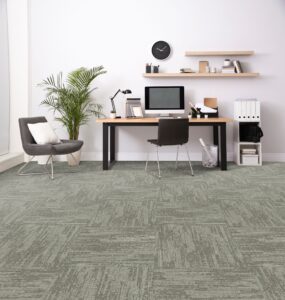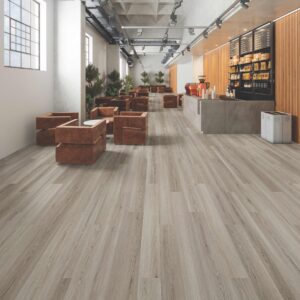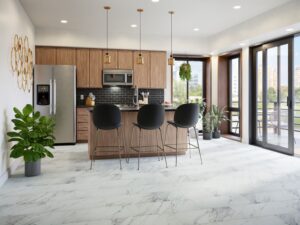
There’s no denying the headwinds facing the industry today, and the bellwether Main Street commercial market is no exception. As we approach the final quarter of 2024, this key market sector is facing a host of issues—the Presidential election not withstanding—that could impact sales and growth opportunities.
“Economic uncertainty, supply chain disruptions and labor shortages are impacting project timelines, costs and overall profitability,” said Eric Ruppert, senior director of product marketing and category management – residential, Engineered Floors.
These and other issues are creating a challenging environment for businesses looking to invest in new flooring. This cautious approach comes during a critical time when investments are necessary to maintain their spaces at the standard needed to attract customers.
“The election year brings uncertainty, which can affect business confidence and investment,” noted Tara Currier, marketing director at Philadelphia Commercial, a Main Street brand of Shaw Industries. “Potential tariff increases could lead to higher costs for materials and goods. Additionally, high interest rates are making borrowing more expensive, which, coupled with a sluggish multi-family housing sector, could slow down overall market growth.”
The situation is worth monitoring for flooring dealers and contractors, as Main Street represents approximately 30% of commercial sales, according to FCNews research. Many flooring dealers expanded into this service-intensive market during the COVID-19 pandemic to diversify their businesses. “While the category was forecast to grow in 2024 in the low single digits, we are seeing the category flat to slightly down,” said David Sheehan, SVP – residential marketing and product, Mannington Mills.
Key market sectors are facing macroeconomic challenges, which are influencing growth rates and flooring choices. For example, retail stores not only compete against each other but face mounting pressure from online shopping. “Retail has been kind of down,” Yon Hinkle, AHF Products’ vice president of product management, observed. “Some of that Main Street commercial business has been healthy while others have not been.”
Many small businesses are reportedly reevaluating their real estate needs, downsizing office footprints and adopting more flexible work-from-home policies, which diminishes the immediate need for refurbishments. Healthcare, the largest commercial segment, is seeing growth that’s driven, in part, by expanding urban healthcare systems acquiring smaller, local providers in suburban areas. And hospitality spaces are creating unique, engaging environments that appeal to a wide range of generations.
Hard surface utilization
Remodeling projects are being dominated by hard surfaces, a category representing approximately 56% of 2023 commercial flooring sales, according to FCNews research. Volume was split between Main Street and specified contract work, showcasing the versatility of hard surfaces across various commercial environments. Leading this charge was resilient, accounting for 35% of commercial hard surface volume and retaining its position as the fastest-growing category.
“There is continued growing demand for resilient flooring, making it crucial to focus on new product solutions in this category to meet market needs,” Philadelphia’s Currier said
LVT, ceramic tile, hardwood and polished concrete are catering to the diverse needs of Main Street, combining style, functionality and resilience to withstand heavy foot traffic. “Subcategories within resilient, such as modular vinyl, whether it is glue down or floated, continue to boom,” AHF’s Hinkle said. “This makes up for a very large percentage, especially when you get into the Main Street part of the business, where it dominates that category.”

An estimated one-third of carpet revenue comes from Main Street applications, with carpet tile prevailing in spaces such as healthcare, hospitality and retail. Broadloom carpet, while less dominant, remains strong in hospitality and certain Main Street settings. “Broadloom is a declining category but there is growth in hospitality,” said Robb Myer, vice president of Aladdin Commercial. “When you look at the typical Main Street customer, they tend to mix flooring because they may have a high-traffic area where they put carpet tile but value-engineer and put broadloom in another area.”
Main Street businesses are increasingly influenced by interior design trends, driving changes in flooring choices that reflect both aesthetics and functionality. As customers seek out unique, memorable shopping experiences, business owners are turning to innovative flooring options that align with contemporary design movements, industry members say. “Businesses want to show more personality in their spaces and are doing so with products that have more expressive patterns, texture and detail,” Currier said. In particular, she cited Philadelphia Commercial’s geometry-inspired Reset & Refocus line, which boasts sophisticated colors and contemporary color blocking for a layered and textural look.
Demand for customizable and unique interiors has led to an increase in the use of LVT and luxury vinyl plank. These versatile products allow businesses to mimic the look of wood, stone or even ceramic at a fraction of the cost while offering the flexibility to achieve a bespoke design. For example, Mannington reports an increase in cherry and maple visuals in LVP and concrete designs in a 12 x 24 format, patterns found in its City Line Collection.
Sustainability factor

While color and design are major selling points, sustainability is becoming a central concern for consumers and businesses alike. To that end, Main Street businesses are rethinking their flooring choices to align with eco-friendly practices. From cafes to boutiques, the demand for sustainable materials is reshaping flooring choices, influencing both aesthetics and functionality in commercial spaces.
“These surfaces are not only durable, making them easy to clean and maintain, but they also offer a long lifespan,” Philadelphia’s Currier pointed out. “This longevity reduces the need for frequent replacements, which in turn minimizes waste and resource consumption.”
A significant shift is the increasing preference for materials with lower environmental impacts. For example, flooring made from eco-friendly
The post Main Street: State of the industry 2024 appeared first on Floor Covering News.
Main Street: State of the industry 2024 Posted First on https://fcnews.net
No comments:
Post a Comment